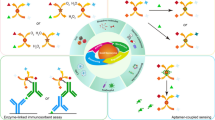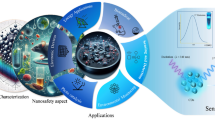Abstract
The influence of several factors on the activity of cholesterol oxidase (ChOx) transiently exposed to a room temperature ionic liquid (RTIL) was studied. Presence of flavin adenine dinucleotide (FAD, prosthetic group of ChOx) during exposure to RTIL makes the procedure enzyme-friendly, while the use of RTIL (green reagent) makes it environmentally-friendly. Following exposure to RTIL and its subsequent removal, FAD becomes part of the molecular structure of the refolded protein (a molecular “wire”). This makes the procedure used here a molecular one. The factors studied were: FAD presence in RTIL during modification, water presence during exposure to RTIL, and ratio FAD:RTIL during “wiring”. Performance parameters monitored were: enzyme activity before and after “wiring” (expressed as (dA/dt)/mg enzyme, and measured spectrophotometrically), peak current in an amperometric biosensor for cholesterol detection, and linearity of the biosensor response depending on cholesterol concentration. After RTIL removal, the modified enzyme (ME) retained a high percentage of the added FAD, which supplemented that of the native enzyme (functioning as a “wire” and enhancing electron transfer kinetics), and a fraction of the initial activity. Used in an amperometric biosensor, ME showed catalytic activity, linear behavior as a function of cholesterol concentration, and stability.

Similar content being viewed by others

Abbreviations
- ChOx:
-
Cholesterol oxidase
- HPLC:
-
High performance liquid chromatography
- RTIL:
-
Room temperature ionic liquids
- FAD:
-
Flavin adenine dinucleotide
- [EMIM]BF4 :
-
1-Ethyl-3-methylimidazolium tetrafluoroborate
- LDH:
-
Lactate dehydrogenase
- ME:
-
Modified enzyme
- GC:
-
Glassy carbon
- SCE:
-
Standard calomel electrode
- EtOH:
-
Ethanol
References
Campbell MK, Shawn OF (2005) Biochemistry, 4th edn. Thomson Asia Pte Ltd., Singapore
Allain CC, Poon LS, Chan CSG, Richmond W, Fu PC (1974) Enzymatic determination of total serum cholesterol. Clin Chem 20(4):470–475
Hurst WJ, Aleo MD, Martin RA Jr (1983) High performance liquid chromatographic analysis of cholesterol in milk. J Dairy Sci 66(10):2192–2194
DiCarlo CM, Compton DL, Evans KO, Lazlo JA (2006) Bioelectrocatalysis in ionic liquids: examining specific cation and anion effects on electrode-immobilized cytochrome c. Bioelectrochemistry 68:134–143
Naushad M, Alotman ZA, Khan AB, Ali M (2012) Effect of ionic liquid on activity, stability, and structure of enzymes: a review. Int J Biol Macromol 51:555–560
Lange C, Patil G, Rudolph R (2005) Ionic liquids as refolding additives: N′-alkyl and N′-(ω-hydroxyalkyl) N-methylimidazolium chlorides. Protein Sci 14:2693–2701
Welton T (1999) Room-temperature ionic liquids. Solvents for synthesis and catalysis. Chem Rev 99:2071–2083
Park S, Kazlaukas RJ (2001) Improved preparation and use of room temperature liquids in lipase-catalyzed enantio- and regioselective acylations. J Org Chem 66:8395–8401
Fouad M, Ramachandran P, Agostino N, Aurian-Blajeni B, Leonida MD (2007) Ionic liquids denaturing/stabilizing agents for proteins. 52nd Annual meeting NJAS, Kean Univ, April 21
Heller A (1990) Electrical “wiring” of enzymes. Acc Chem Res 23(5):128–134
Degani Y, Heller A (1989) Electrical communication between redox centers of glucose oxidase and electrodes via electrostatically and covalently bound redox polymers. JACS 111:2357–2358
Leonida MD, Sobolov SB, Fry AJ (1998) FAD—mediated conversion of NAD+ to NADH. Application to chiral synthesis of l-lactate. Bioorg Med Chem Lett 8:10–13
Leonida MD, Starczynowski DT, Waldman R, Aurian-Blajeni B (2003) Polymeric FAD used as enzyme-friendly mediator in lactate detection. Anal Bioanal Chem 376(6):832–837
Arya SK, Datta M, Mahotra BD (2008) Recent advances in cholesterol biosensor. Biosens Bioelectron 23:1083–1100
Richmond W (1973) Preparation and properties of a cholesterol oxidase from Nocardia sp. and its application to the enzymatic assay of total cholesterol in serum. Clin Chem 19(12):1350–1356
Meng QH, Irwin WC, Fesser J, Massey KL (2005) Interference of ascorbic acid with chemical analytes. Ann Clin Biochem 42(6):475–477
Goto M, Kamiya N, Moniruzzaman M (2010) Activation and stabilization of enzymes in ionic liquids. Org Biomol Chem 8:2887–2899
Dontapati S, Katakis I, Mir M, Vreeke M (2007) Enzymatic self-wiring. Electrochem Commun 9(7):1715–1718
Marcus RA, Sutin N (1984) Electron transfers in chemistry and biology. Biochim Biophys Acta Rev Bioenerg 811(3):265–322
Ramachandran P, Fouad M, Aurian-Blajeni B, Shrestha S, Leonida MD (2012) Ionic liquids used in enzyme “wiring”. Nonlinear Opt Quantum Opt 44(2–3):167–175
Motterani L, Pilone MS, Molla G, Ghisla S, Pollegioni L (2001) Cholesterol oxidase from Brevibacterium sterolicum. The relationship between covalent flavinylation and redox properties. J Biol Chem 276(21):18024–18030
Roschlau P, Bernt E, Gruber W (1974) Enzymatische Bestimmung des Gesamt Cholesterins in Serum. J Clin Chem Clin Biochem 12:403–407
Author information
Authors and Affiliations
Corresponding author
Rights and permissions
About this article
Cite this article
Leonida, M.D., Aurian-Blajeni, B. Molecularly “Wired” Cholesterol Oxidase for Biosensing. Protein J 34, 68–72 (2015). https://doi.org/10.1007/s10930-015-9599-9
Published:
Issue Date:
DOI: https://doi.org/10.1007/s10930-015-9599-9



